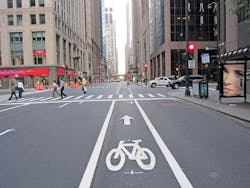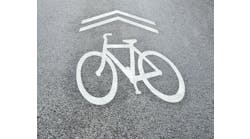Can street design contribute to greater social equity?
For people who do most of their daily trips by car, it might not be obvious how things like street design and social equity are related. But for anyone who does their daily trips on foot, by bike or on transit, how a street is designed and built can be an enormous factor in physical safety, long-term health, economic mobility and the simple need to get where you want to go.
Walking continues to be dangerous on too many streets in America. Between 2005 and 2014, a total of 46,149 people were struck and killed by cars while walking. In 2014, the most recent year for which data are available, 4,884 people were killed by a car while walking—105 people more than in 2013. On average, 13 people were struck and killed by a car while walking every day in 2014. That is the equivalent of one fully loaded Boeing 777 crashing every month.
Where are America’s streets least safe for walking? It sadly comes as little surprise that low-income communities are disproportionately burdened with this problem. Research has shown that the rate of fatal pedestrian crashes is strongly correlated with median household income and rates of uninsured individuals. This research has shown that low-income metro areas are predictably more dangerous than higher-income ones: As median household incomes drop, pedestrian danger rises. Similar trends bear out with rates of uninsured individuals: As rates of uninsured individuals rise, so does pedestrian danger. This means that the people who can least afford to be injured often live in the most dangerous places.
We see these trends reflected in the faces of fatalities. People of color are more likely to be struck and killed by a car while walking than white individuals. Non-white individuals account for 34.9% of the national population, yet they make up 46.1% of pedestrian deaths. In some states, this disparity is particularly stark. In North Dakota, for example, Native Americans make up just 5% of the population but account for almost 38% of pedestrian deaths.
This clear disparity in pedestrian deaths comes against the backdrop of a growing obesity crisis in the U.S., a crisis that also disproportionately impacts low-income communities and communities of color. The U.S. Surgeon General has issued a formal Call to Action on obesity—the same type of alarm raised for cigarette smoking several decades ago—and is encouraging more biking and walking as part of daily routines to help curb it. Unfortunately, in too many communities, these activities simply are not safe.
The problem and the solution
Street design is a factor in all of this. We know this because fatal collisions are not dispersed randomly across geography; they occur repeatedly at particular intersections and along certain corridors. Roads with wide, straight lanes can encourage people to drive faster than on streets with narrower lanes. And common practice in traffic engineering calls for speed limits to be set based on how fast drivers tend to go on a given section of roadway—a self-fulfilling prophecy when roads are designed for higher speeds. This practice increases the likelihood that any collision with a pedestrian will be fatal. Yet this type of road design is often applied to streets that go through communities that are lined with homes, shops, schools and offices, where people need and want to walk.
Street design is part of the problem, so it also is part of the solution. Understanding how people use—and want to use—streets and public spaces is the first step. On streets or in areas where people want to walk or bike, engineers should take rigorous steps to reduce traffic speeds, build infrastructure to safely accommodate people walking or biking, reduce crashes and do everything possible to make sure crashes that do happen are not fatal.
A complete streets approach helps transportation planners and engineers to see streets from this perspective, and to consider how to make a street safe and convenient for everyone who uses it. In general, this approach seeks to keep people walking separate from people driving vehicles; keep traffic speeds low; ensure sidewalks and curb ramps are accessible to people with disabilities; and clarify where each road user should be expected to travel. With these principles set, planners, landscape architects and engineers can select from a large set of nationally used, appropriate design elements, including wider sidewalks; curb extensions; refuge islands; pedestrian countdown signals; leading pedestrian-interval signal timing; midblock crossings (especially at transit stops); pedestrian hybrid beacons; narrow travel lanes; planting street trees; restricted right turns on red lights; compact intersections; back-in angled parking; and smaller curb radii.
Making gains
A complete streets policy can help make sure this approach is applied routinely. Complete streets policies are a jurisdiction’s formal commitment to fund, plan for, construct, operate and maintain their streets with all users in mind. The National Complete Streets Coalition (NCSC) recognizes several types of statements in its definition of a complete streets policy, including legislation, resolutions, executive orders, internal policies, policies adopted by an elected board, tax ordinances, comprehensive or master plans, and design guidance.
Nationwide, a total of 1,232 policies are now in place, in all 50 states, Puerto Rico, and the District of Columbia, including 33 state governments, 77 regional planning organizations, and 955 individual municipalities. These policies have become progressively stronger over time, and each year the NCSC scores new policies to track this progress. When the NCSC first evaluated complete streets policies in 2006, the median score was 34. By 2015 the median score had risen to 68.4. In 2016, the median score leapt to 80.8. Before 2012, no policy had scored higher than 90. And it wasn’t until 2015 that any policy scored a perfect 100. In 2016, 51 policies scored a 90 or higher, including three policies that scored a perfect 100.
These gains are a testament to communities’ commitment to making streets that are safe and convenient for everyone. Yet the communities that pass these polices tend to be more white and more wealthy than the U.S. as a whole. In all, 77% of localities that passed complete streets policies in 2016 had white populations greater than the national average of 73.6%. The median household income of communities who passed or updated a policy in 2016 was $59,347, about 10% above the national average of $53,889. Policies anywhere are a step in the right direction toward streets that are safer for walking. But more needs to be done to make sure that movement is inclusive and equitable.
A case in point
One community working to bring a complete streets approach to Americans of all income levels, races and ethnicities is Richton Park, Ill., a suburban community 26 miles outside of Chicago.
“Richton Park is a traditional suburb, in that for the most part you need a car to get around,” said Regan Stockstell, village manager for Richton Park. “It was established as a bedroom community, so you often have to travel outside the community to get to things, whether it’s recreational, or service needs, or shopping.”
The village began considering a complete streets policy for a number of reasons, including creating a comprehensive network for all modes of transportation, improving community health, increasing safety and advancing economic development goals. And village leadership knew that if the policy was going to benefit residents, residents would need to help inform it. The village set up a steering committee to help make sure the policy would work for everyone.
“The committee was set up in an effort to be inclusive,” Stockstell explained, “to keep as many people involved as possible, so that once the policy was adopted it would be mutually accepted by the residents of the community.”
Richton Park successfully adopted its complete streets policy last year, and plans to use it to guide planning processes, road enhancements, an upcoming capital improvement plan, and other opportunities to make the village more multimodal. The policy is custom-fit to Richton Park’s needs, and that is one of its creators’ proudest point.
“For three months we looked at different policies from around the country,” Stockstell said. “We looked at a lot from our neighboring communities in particular. We know many people who have done the hard work, and we took out pieces of each to create our own policy. Policies aren’t meant to be cookie-cutter. You have to find what works for your community.”
Getting there
In communities across the country, people walk along dangerous roads despite the clear safety risk. This is not a collective movement toward daredevilry, or a lack of understanding about how dangerous it can be to walk along fast-moving traffic. It is a symptom of systematic inequalities, and a sign that these streets are failing to serve the needs of everyone in a community.
A complete streets approach can help make streets safer and more convenient for everyone—regardless of their age, race, ethnicity, income, physical ability or how they choose to travel. That is an important part of building a better transportation system. It also is an important part of building more equitable and inclusive communities nationwide.



